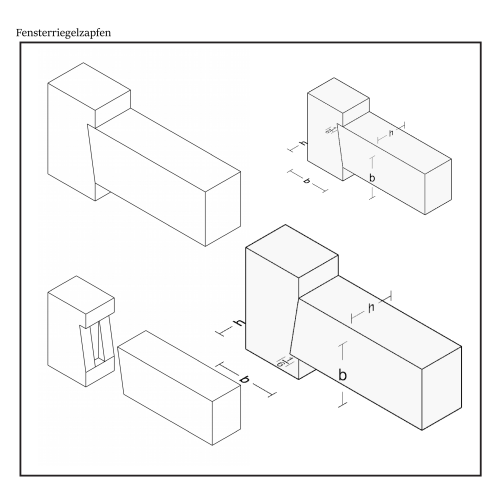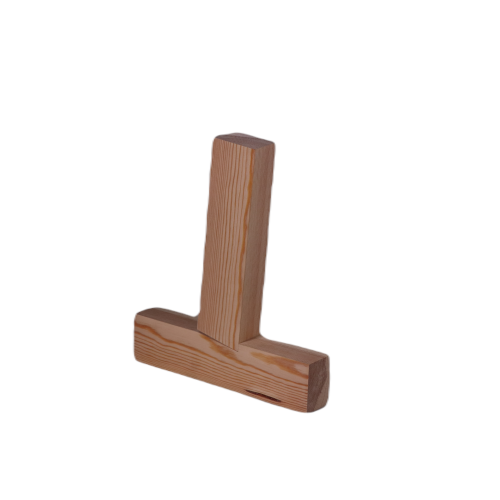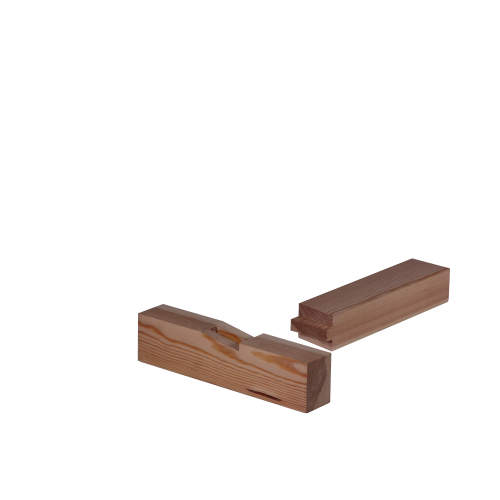window transom tenon
Downloads
- Download 3DM File
- Download FactSheet File
The window transom tenon is a rather complex joint that protects the end grain to its full extent. As the name suggests, it is applied to create window and door lintels. Geometrically, an angled support is mortised into the stud beam to create the support for the cross beam. This connection secures the bearing against both lifting and lateral displacement. Furthermore, the more absorbent end-grain timber surfaces are protected against the weather. Loads are thus easily transferred to the uprights. The connection comes from the carpenters' trade (cf.Gerner, 1992, p. 144).
Mortise and tenon joints
Along with leaves, tenon joints are one of the oldest and most widespreada types of wood joint. The developmental stages of the tenon can hardly be traced, but it is certain that at the latest in 3000 BC wooden joints were made in the form of "insertion holes". Tenons for doors and gates were already known (cf. Gerner, 1992, p. 53). Due to the universal usability of tenons, they contribute decisively to constructive solutions and even make them possible. Thus, the mortise and tenon, a mortise and tenon that is secured with wedges or split pins, is considered the basis and most important element of all house frames and anchor beam constructions. For some constructions, the mortise and tenon joint is already considered the constructive basis at that time (cf. Gerner, 1992, p. 53).
Offset connections
There are no longitudinal joints in the family of offsets. Probably the simplest form of offset can be found among lumberjacks. They drive stakes into the ground for stacking the logs, which are supported by lateral beams. For this purpose, an offset is hammered into the support (cf. Gerner, 1992, p. 139).
Der Fensterriegelzapfen ist eine recht komplexe Verbindung, die im vollen Umfang das Hirnholz schützt. Wie der Name schon sagt, wird er angewandt, um Fenster- und Türstürze zu erstellen. Geometrisch wird ein schräges Auflager im Ständerbalken eingestemmt und so das Auflager für den Querbalken erstellt. Durch diese Verbindung wird das Lager sowohl gegen das Abheben als auch gegen das seitliche Verschieben gesichert. Des Weiteren sind die saugstärkeren Hirnholzflächen gegen die Witterung geschützt. Lasten werden so einfach in die Ständer geleitet. Die Verbindung kommt aus dem Handwerk der Zimmermänner (vgl.Gerner, 1992, S. 144).
Zapfenverbindungen
Zapfenverbindungen gehören neben Blättern zu den ältesten und weitest verbreitetena Holzverbindungsarten. Die Entwicklungsstufen des Zapfens sind kaum nachzuvollziehen, jedoch steht fest, dass spätestens 3000 v. Chr. Holzverbindungen in Form von „Einsatzlöchern“ ausgeführt wurden. Bekannt waren bereits auch Drehzapfen für Türen und Tore (vgl. Gerner, 1992, S. 53). Durch die universelle Verwendbarkeit von Zapfen tragen diese entscheidend zu konstruktiven Lösungen bei und ermöglichen diese sogar. Somit gilt das Zapfenschloß, ein durchgesteckter Zapfen der mit Keilen oder Splinten gesichert wird, als die Basis und wichtigstes Element aller Hausgerüste und Ankerbalkenkonstruktionen. Für einige Konstruktionen gilt schon damals das Zapfenschloss als die konstruktive Basis (vgl. Gerner, 1992, S. 53).
Versatzverbindungen
Bei der Familie der Versätze gibt es keine Längsverbindungen. Die wohl einfachste Form des Versatzes lässt sich bei den Holzfällern finden. Sie treiben Pfähle in die Erde zum Stapeln der Stämme, die durch seitliche Balken abgestützt werden. Hierfür wird ein Versatz in die Stütze eingeschlagen (vgl. Gerner, 1992, S. 139).






